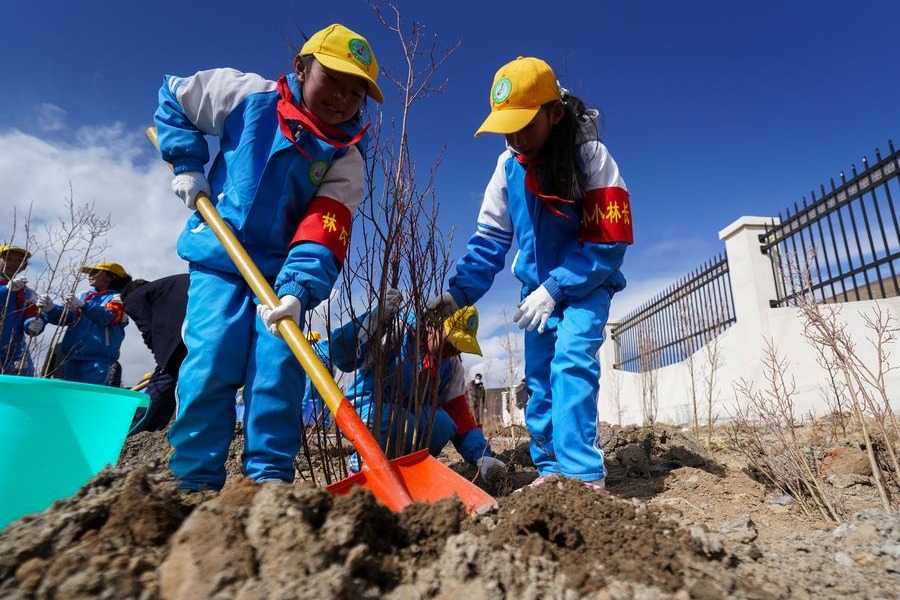Policy to boost cotton industry in Xinjiang
Ministry vows new measures to expand long-staple type in autonomous region


The Ministry of Agriculture and Rural Affairs has pledged more support to help the Xinjiang Uygur autonomous region reclaim its vast areas of infertile land and expand its competitive edge in growing long-staple cotton — a crop that underpins a sprawling supply chain that stretches from textile production in Guangdong province to the fashion industry in Shanghai.
Minister Han Jun had a meeting with regional government officials on Saturday, during which he announced that his administration would enhance policy measures to support Xinjiang in increasing its comprehensive crop production capacity, including for long-staple cotton, according to a media release on the ministry's website.
The support will be provided in areas such as treating saline-alkali land, promoting water-efficient irrigation technologies, and sponsoring the research, development and dissemination of homegrown cotton-picking machines.
"Continued efforts will be made to promote the development of high-quality long-staple cotton," the release quoted the minister as saying.
Home to more than 90 percent of China's annual cotton output, Xinjiang has remained the top provincial-level jurisdiction in terms of both cotton output and productivity for the past three decades.
The use of machines in cotton harvesting in the region has also soared in recent decades to over 85 percent, with domestic branded machines emerging as the predominant choice in the industry, Xinhua News Agency has reported.
As part of a national campaign to raise China's crop output and self-sufficiency, Xinjiang launched a program earlier this year to boost cotton productivity through initiatives such as promoting higher-yielding varieties.
Data published earlier this month by local authorities revealed significant progress.
Output has surpassed 11.5 metric tons per hectare in an experimental field spanning approximately 7 hectares, with over 8.4 tons achieved in a demonstration zone covering about 670 hectares.
These figures represent a substantial improvement compared to the mainstream cotton varieties planted across Xinjiang, which typically yield from 6 to 7.5 tons per hectare.
More importantly, the increased yield had not affected the quality of the harvest, local authorities stressed.
In some areas, including Kashgar, a major cotton-growing region, AI-powered breeding techniques have been deployed to develop cotton varieties endowed with traits such as drought tolerance and pest resistance.
The next-generation varieties, coupled with smart farming management that has minimized the use of fertilizers and pesticides, have improved productivity to almost 8 tons per hectare at a local experimental field.
The ministry's announcement coincided with an increased effort to utilize otherwise infertile areas for crop production as China aims to expand planting areas and ensure self-sufficiency for key materials amid vulnerable global supply chains and more frequent extreme weather events.
At a meeting in July last year, central authorities emphasized the need to tap the potential of saline-alkali land and increase overall agricultural production capacity.
They called for better use of abandoned and nonconventional farmland, and more funding for related research. They also highlighted the significance of development model innovations in overcoming the natural constraints of farmland scarcity.
Efforts to enhance the cotton industry in Xinjiang, once home to some of the nation's most entrenched poverty, are also part of a national rural vitalization initiative.
Erkin Tuniyaz, chairman of the region, said at the meeting that efforts will be made to vigorously increase the production of important agricultural products, including cotton, and strengthen the development of high-standard farmland that is more resilient to extreme weather.
He said the government will spare no effort in promoting the prosperity and stable income growth of agricultural and pastoral areas, and make more contributions to ensure national food security and the supply of important agricultural products.
With an aim to improve the added value of cotton production, Liang Yong, a national political adviser and director of Xinjiang's cotton industry development leading group office, told China Daily that there is a need to further bolster the development of Xinjiang's cotton-textile-apparel industry chain.
"This entails facilitating more cotton-related manufacturing in Xinjiang relocated from the eastern regions, and driving forward the convergence of the cotton and petrochemical industries," he said.
- Pioneering university cultivating top-tier talent in AI
- Air Force rebuffs Pakistan supplies claim
- China launches new remote sensing satellites
- Ancient fish fossil find places puzzling species among jawed vertebrates
- China vows to achieve reunification, counter separatism
- China-donated tents seen in relief shelter in Mandalay, Myanmar





































